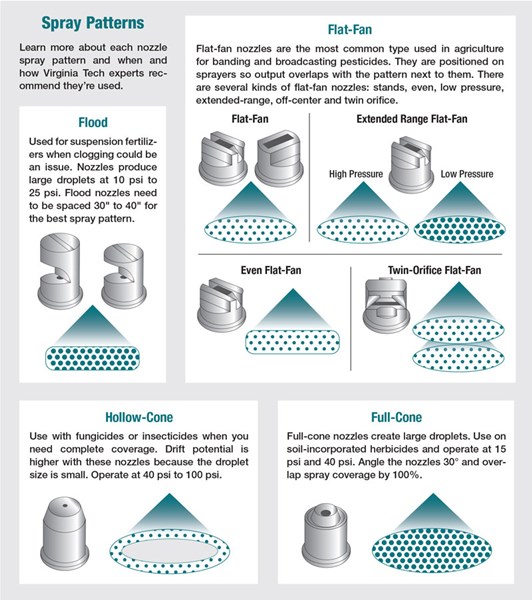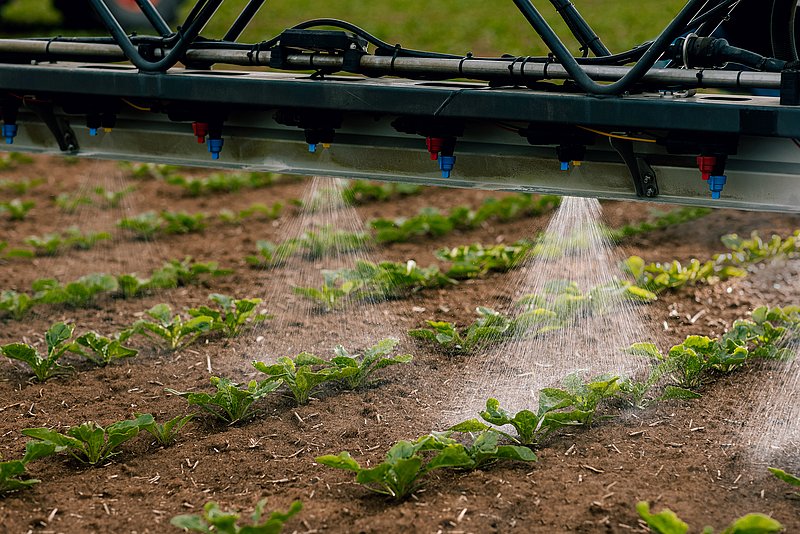
Agricuture Sector
The Agricultural Sector and Nozzle Technology
The agricultural sector is the primary source of food production worldwide, and technological innovations are needed in this sector to increase efficiency, ensure sustainability, and use resources more effectively. Nozzle technology plays a crucial role in achieving these goals, especially by ensuring the accurate distribution of liquids, pesticides, fertilizers, water, and other agricultural chemicals. Nozzles are used as part of water and chemical distribution systems in agricultural machinery and are one of the most important pieces of equipment that increase efficiency in modern agriculture.
Areas of Use of Nozzle Technology in Agriculture
Irrigation Systems:
In agriculture, the proper distribution of water is of great importance. Irrigation nozzles provide the moisture that plants need by spraying water evenly onto the soil. Nozzles used especially in drip irrigation and sprinkler systems are designed for the efficient use of water.
Usage: Sprinkler irrigation, drip irrigation, low-pressure irrigation.
Pesticide and Fertilizer Distribution:
Pesticides and fertilizers are important for the healthy growth of plants and their protection from pests. Nozzles are used to spray these chemicals homogeneously onto the plants. Special nozzles used in agriculture ensure that medicines are distributed in the right amount and in the right way.
Usage: Pesticide applications, fertilizer applications, weed control.
Liquid Drug and Protective Applications:
In agriculture, various liquid medicines are used to protect plants from diseases. Nozzles ensure that these medicines are distributed equally to the plants and increase their effectiveness. In addition, liquid applications should be done without harming the soil and the environment.
Usage: Fungicides, insecticides, foliar nutrient solutions.
Fertilization and Soil Improvement:
The correct nozzle selection is important for the proper application of chemical fertilizers and organic fertilizers to the soil. Nozzles used in this process ensure that the fertilizer is distributed correctly on the soil surface, thus ensuring that plants receive the nutrients they need effectively.
Usage: Liquid fertilization, foliar fertilization, soil conditioners.
Greenhouse Cultivation and Temperature Control:
In greenhouses, the humidity and temperature control of the environment is very important for the healthy growth of plants. Nozzles are used for both irrigation and humidity control in greenhouses. In this way, the most suitable environmental conditions are provided for the plants.
Usage: Irrigation in greenhouses, humidity control.
Benefits of Nozzle Technology in Agriculture
Increased Efficiency:
Nozzles ensure that the water, fertilizers, and pesticides used in agriculture are applied in the right amount and at the right time. This ensures that plants receive the nutrients they need most efficiently and are protected from pests. This increases yield.
Water Conservation:
Water is one of the most valuable resources in agriculture. Nozzle technology ensures that water is used more efficiently by ensuring that it is distributed correctly. This is of great importance, especially in arid regions.
Reduction of Chemical Use:
The correct and efficient application of chemicals used in agriculture optimizes the use of pesticides and fertilizers without harming the environment. The correct use of nozzles reduces chemical waste and creates an environmentally friendly agricultural practice.
Time and Labor Savings:
Modern nozzle systems allow you to carry out agricultural applications more quickly and effectively. This saves labor while also saving time.
Better Product Quality:
Since nozzles ensure that liquids are distributed evenly on plants, they help to obtain healthier and higher quality products. At the same time, plants experience less stress and grow stronger.
Types and Features of Nozzles

Flat Fan Nozzles:
Flat fan nozzles spread water or liquid over a wide area. These nozzles provide efficiency in large areas, especially in irrigation and fertilization systems.
Advantages: Wide spray area, even water distribution, use in large areas.
Full Cone Nozzles:
Full cone nozzles spray liquid in the shape of a wide cone, which allows the liquid to spread over a wider area. These nozzles increase efficiency in irrigation and pesticide applications.
Advantages: Effective liquid distribution in wide areas, fine atomization.
Drip Irrigation Nozzles:
Drip irrigation nozzles deliver water directly to the roots of plants. These nozzles ensure that water is given only to the part of the plants that need it, thus preventing water waste.
Advantages: Water saving, precise irrigation, direct root irrigation.
Air Atomizing Nozzles:
These nozzles atomize by mixing air and liquid. In agriculture, it is used for the homogeneous distribution of pesticides and fertilizers.
Advantages: Fine atomization, homogeneous distribution of chemicals.
High Pressure Nozzles:
High pressure nozzles spray liquid at a very high speed. These nozzles are usually used in large areas to combat harmful insects and weeds.
Advantages: High spraying power, effective pest control.
Conclusion
Nozzle technology is an important component that increases efficiency in the agricultural sector and promotes environmentally friendly practices. Nozzles used in areas such as irrigation, fertilization, pesticide applications, and greenhouse cultivation optimize water and chemical use while increasing product quality. The correct types of nozzles used in agriculture provide both economic benefits and reduce environmental impact. For this reason, nozzle technology has a great importance in modern agriculture and supports the progress in the sector.
Nozzle Types Commonly Used in the Agricultural Sector
Nozzles used in the agricultural sector are extremely important for watering, fertilizing, pesticide applications, and other agricultural operations of plants. Each type of nozzle is optimized for a specific agricultural application and helps to distribute water, fertilizers, or chemicals accurately and efficiently. Here are the types of nozzles commonly used in the agricultural sector:
Flat Fan Nozzles
Areas of Use: Plant protection, pesticide applications, fertilization.
Features: These nozzles distribute the liquid evenly over a wide plane, spreading it evenly over the plants. They are generally used in large areas and ensure that liquids are spread homogeneously.
Advantages:
Provides high accuracy and homogeneous liquid distribution.
Provides effective use in large areas.
The spray angle can be adjusted, usually between 80° and 120°.
Full Cone Nozzles
Areas of Use: Irrigation, pesticide and fertilizer applications.
Features: These nozzles distribute the liquid in the shape of a wide cone, allowing it to spread over a wider area. Full cone nozzles are used especially in cases where water or chemicals need to be distributed evenly.
Advantages:
Provides effective liquid distribution in large areas.
High efficiency and fine droplet size are achieved.
Drip Irrigation Nozzles
Areas of Use: In drip irrigation systems used to deliver water directly to the roots of plants.
Features: Drip irrigation nozzles are used to deliver water directly to the root zone of plants. These nozzles provide water slowly and efficiently, thus preventing water waste.
Advantages:
Saves water.
Provides precise irrigation, ensuring that water is given only to the plant roots.
Maintains soil moisture, but prevents water loss.
High Pressure Nozzles
Areas of Use: Pesticide applications in agriculture and spraying water in large areas.
Features: High-pressure nozzles provide effect in larger areas by spraying the liquid at high speed. These nozzles are especially used to combat pests in large agricultural areas.
Advantages:
Provides the ability to spray liquid over long distances.
Effective under high pressure and offers a powerful cleaning function.
Atomizing Nozzles (Air Atomizing Nozzles)
Areas of Use: Liquid fertilization, pesticide applications, atomization of foliar nutrient solutions.
Features: These nozzles atomize liquids by mixing them with air and distribute them in fine droplets. They are used especially in applications that require fine atomization.
Advantages:
Ensures homogeneous distribution of liquids with fine droplet size.
Ensures that chemicals are used more efficiently, so you get the same yield with less chemicals.
Spiral Nozzles
Areas of Use: Industrial cooling and liquid distribution in agriculture.
Features: Spiral nozzles create a more homogeneous area by distributing the liquid in a spiral manner. These nozzles are especially used in pesticide or fertilizer applications in agriculture.
Advantages:
Provides effective liquid spread with high pressure.
Ensures equal distribution of water or chemicals with high efficiency.
Split Flow Nozzles
Areas of Use: Irrigation, pesticide applications.
Features: These nozzles divide the liquid into multiple flows and allow it to spread over a wider area. They are often known as multi-headed nozzles.
Advantages:
Provides equal liquid distribution in wider areas with multiple flows.
Has the capacity to perform multiple operations at the same time.
Micro Nozzles
Areas of Use: Precise irrigation and fertilization applications.
Features: Micro nozzles provide a more precise liquid distribution by focusing on very small areas. These nozzles are especially used in drip irrigation systems.
Advantages:
Delivers water directly to the roots of plants, thus minimizing water loss.
Irrigation can be done with high precision.

Conclusion
Nozzles used in the agricultural sector support plant growth by ensuring proper liquid distribution, increase efficiency and make it possible to use resources more efficiently. Each type of nozzle is customized for different irrigation and application techniques. Choosing the right nozzle both saves water and ensures that the nutrients and chemicals that plants need are given in the right amounts. Therefore, the correct selection and efficient use of nozzles used in agriculture plays a critical role for a sustainable and efficient agricultural practice.











